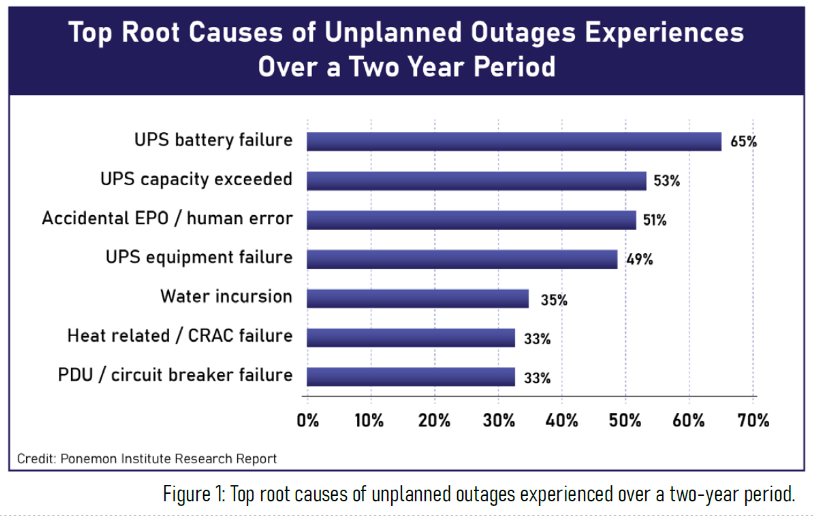Contributed Commentary by JD DiGiacomandrea P.E., Green Cubes
October 12, 2022 | We depend on the availability of electricity more than ever these days. Electricity helps with running your CPAP machine all night, running an oxygen concentrator, or simply keeping your food frozen. More importantly are the larger systems that depend on continuous power, like water and electricity utility switches, telecommunication towers and switching centers, airline and public transportation control centers, and the large data centers powering all our systems. When the grid fails for these loads, backup power must kick in. If there is no backup, bad things can happen; hence, keeping these up and running is critical. Batteries are the most common technology to provide immediate backup power to critical loads.
In 2010, a Ponemon Institute research study discovered that 55% of data center outages and one-third of UPS system failures were due to lead acid battery failure. Unreliable battery performance was the leading cause of unplanned outages, beating out other reasons such as human error, UPS capacity overload, IT or mission-critical infrastructure failure, weather events, or cyberattacks. What can you do to prevent downtime for critical loads?

Luckily, there are multiple ways to predict battery performance before the battery is used. This is a great time to reflect on the old adage, “An ounce of prevention is worth a pound of cure.” First, you need to know what causes your batteries to fail. Then, monitor for signs of these failure modes. Some simple things include:
- Routine visual checks
- Annual preventative maintenance visits
- Monthly battery discharge tests
- Ohmic readings
These actions can provide insight into the battery’s health but typically require a skilled technician to go on-site with each battery system to take measurements and perform checks. Finally, this only helps prevent failure if the data is analyzed and action is taken before a power outage event occurs.
To make this easier, battery management and monitoring systems (BMS) can be installed on your battery system. Lead acid batteries don’t come with a BMS, so it must be purchased, installed, and programmed. This can be time-consuming, expensive, and prone to mistakes. The BMS must be wired to each 2V cell in the battery pack, making a 48V battery require 24 wires just to monitor cells. Even worse, if your battery system is four 12V mono blocks in series for 48V, you can only monitor the monoblock voltage (12V), and the individual cell voltages are hidden from your monitor.
One of the benefits of lithium-ion technologies is that a BMS is required and built into every battery pack from the factory. It is designed and programmed by the manufacturer to monitor the specific battery in which it is installed. This saves users time and money and prevents errors in programming or setting up their own BMS.
So, what is so special about a Lithium Ion BMS, and how does BMS data help prevent downtime? First, BMS features range from simple voltage and current monitoring to high-level algorithms that monitor each cell’s state of charge, health, and internal resistances. Lower-cost batteries typically have the bare essentials of a BMS to keep the system safe but won’t provide higher-level features. More sophisticated and well-designed lithium-ion batteries will offer more features and provide significantly more value through these advanced BMS.
A high-quality BMS will have a communication interface for operators to connect and communicate with these batteries remotely. This interface opens a world of possibilities for operators to monitor data, collect log files, and crunch the numbers automatically. As we know from the Ponemon Institute research study, failure to take action on failed batteries is the leading cause of downtime. Now with lithium-ion battery management systems, it is as easy as monitoring a few fields in all of your batteries remotely.
Simply, now an operator should monitor these fields:
- Battery and cell voltages
- Battery current
- State of charge
- State of health
- Time to empty
- Time to full
- Cycles
These fields contain enough information for an operator to log and analyze the trends to determine overall battery health. For instance, if the State of Health field begins to decline or falls below 80%, the operator can dispatch a technician to replace that battery. This prevents any downtime caused by a failing battery, reduces the trips technicians must take to the site, and allows the operator to log all battery activity to potentially submit a warrant replacement request with the manufacturer.
Many lithium-ion batteries can connect directly to the power system or site monitors used today to provide operators with more data than before. This allows for simple installation and integration of lithium batteries in an existing system.
This becomes even more important when pairing batteries with a hybrid power system such as solar, fuel cell, hydropower, or even off-grid diesel generators. In these applications, the battery is cycled continuously, putting wear on the battery. Using the BMS to monitor the states of health and charge can allow your system to operate more efficiently and prevent downtime.
If you value time, data, trends, increased visibility, and warranty coverage, it might be time to look into lithium batteries for your next critical power system.
JD DiGiacomandrea is the product marketing engineer for Green Cubes Technologies. As a Lithium battery and energy storage industry veteran, JD has over a decade of experience designing lithium batteries and systems for the military, medical, and industrial markets. Additionally, JD has had roles at major battery manufacturers, including Electrical Engineer, Applications Engineer, and Field Sales Engineer, bridging the gap between Engineering and Sales. JD holds a Bachelor of Science in Electrical Engineering from Clarkson University in Potsdam, NY and a Professional Engineering license from the State of New York. He can be reached at jd@greencubes.com.







